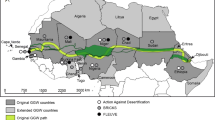Abstract
Northern Rangelands of Kenya have continued to grapple with management challenges largely due to a lack of understanding of the dynamics thereof. Eroding customary institutions and new institutional arrangements characterize the system suggesting that adaptation is taking place to cope with the change. It is imperative that these socio-ecosystems adjust to the disturbance without disintegrating into a different state that is controlled by a different set of processes to ensure sustainable rangeland management. To understand the nature of change, the study sought to evaluate institutional arrangements engaged in tackling growing socio-economic and ecological factors challenging development within the last decade. Three study sites namely Kinna, Makurian and Westgate, representing three types of institutional arrangements (elders only, group ranch committee and community conservancy board), were investigated. Key informants, focused group discussions and household survey methods were used to gather data. Data were managed and analysed using Ms Access, Ms Excel, social network analysis and SPSS. Findings indicate that more actors (internal and external) are engaging in management of social economic and ecological factors challenging development within the last decade. The co-management approach allows increased capacity to tackle these challenges and further presents more opportunities for a diversified livelihood, two key features of ecosystem resilience. Findings are useful as the Kenya government implements the National Land Policy that recognizes the need to restructure community land and its management.







Similar content being viewed by others
Notes
Resilience is defined as the capacity of an ecosystem to cope with disturbance without disintegrating into a different state that is controlled by a different set of processes.
Social-ecological resilience is the capacity of linked social-ecological systems to handle disturbance while maintaining the capacity for adaptation, learning and transformation (Folke et al. 2010).
“In Garbatulla, a local NGO Resource Advocacy Program (RAP) is working with local communities and the local government to document relevant customary laws on natural resource management among the Boran. Kenyan laws have provisions for incorporation of these by-laws, and once the Minister gazettes the laws it will form part of the legal system.”
References
Bahadur, A. V., Ibrahim, M., & Tanner, T. (2010). The resilience renaissance? Unpacking of resilience for tackling climate change and disasters: Strengthening climate resilience discussion paper 1. UK: Institute of Development Studies.
Carlsson, L., & Berkes, F. (2005). Co-management: Concepts and methodological implications. Journal of Environmental Management, 75, 65–76.
Carpenter, S. R., & Gunderson, L. H. (2001). Coping with collapse: Ecological and social dynamics in ecosystem management. BioScience, 51, 451–457.
Crona, B. (2006). Supporting and enhancing development of heterogeneous ecological knowledge among resource users in a Kenyan seascape. Ecology and Society, 11(1), 32.
Folke, C. (2006). Resilience: The emergence of a perspective for social-ecological systems analyses. Global Environmental Change, 16, 253–267.
Folke, C., Carpenter, S., & Walker, B. (2010). Resilience thinking: Integrating resilience adaptability and transformability. Ecology and Society, 15(4), 20.
Holling, C. S. (1973). Resilience and stability of ecological systems. Institute of Resource Ecology: University of British Columbia, Canada.
Holling, C. S., & Walker, B. (2003). Resilience defined. Entry prepared for the Internet encyclopedia of ecological economics. International Society of Ecological Economics.
Israel, G. D. (2009). Determining sample size. Gainesville: Program Evaluation and Organizational Development (PEOD), Institute of Food and Agricultural Sciences (IFAS), University of Florida.
Levin, S. A. (1998). Ecosystems and the biosphere as complex adaptive systems. Ecosystems, 1, 431–436.
Mcpeak, J. G., Doss, C. R., Barrett, C. B., & Kristjanson, P. (2009). Do community members share development priorities? Results of a ranking exercise in East African Rangelands. The Journal of Development Studies, 45(10), 1663–1683.
Nadasdy, P. (2003). The politics of resilience. In D. Armitage, F. Berkes, & N. Doubleday (Eds.), Adaptive co-management: Learning, collaboration and multi-level governance. Vancouver: UBC Press.
Odhiambo, M. O. (2013). Releasing our full potential: The ASAL policy, its promise and challenges. A briefing note for members of county assemblies, community representatives, leaders, CSO and ASAL stakeholders. Nakuru: Reconcile.
Olsson, P., Folke, C., & Berkes, F. (2004). Adaptive co-management for building resilience in social–ecological systems. Environmental Management, 34(1), 75–90.
Pinkerton, E. (1989). Attaining better fisheries management through co-management prospects, problems and propositions. In E. Pinkerton (Ed.), Co-operative management of local fisheries: New direction in improved management and community development (pp. 3–33). Vancouver, BC: University of British Columbia Press.
Sombroek, W. C., Braun, H. M. H., & van der Pouw, B. J. A. (1982). Explanatory soil map and agro-climatic zone map of Kenya. Report E1. National Agricultural Laboratories, Soil Survey Unit, Nairobi, Kenya, 56 pp.
UNOCHA. (2009). Kenya: Humanitarian situation. United Nations Office for the Coordination of Humanitarian Affairs. November 2009.
USAID. (2010). Enhanced livelihoods in Mandera triangle/enhanced livelihoods in Southern Ethiopia newsletter. Nairobi: USAID.
Wilkinson, C. (2012). Social ecological resilience and planning an interdisciplinary exploration. Stockholm: Department of Systems Ecology, Stockholm University.
Author information
Authors and Affiliations
Corresponding author
Rights and permissions
About this article
Cite this article
Kanyuuru, C.K., Mburu, J. & Njoka, J. Adaptation of institutional arrangements to management of Northern Rangelands of Kenya. Environ Dev Sustain 19, 67–82 (2017). https://doi.org/10.1007/s10668-015-9718-y
Received:
Accepted:
Published:
Issue Date:
DOI: https://doi.org/10.1007/s10668-015-9718-y




